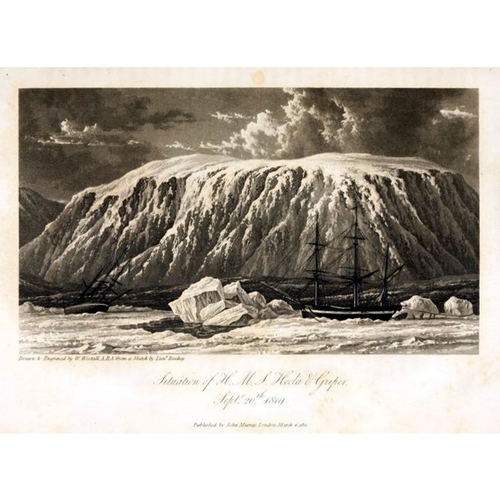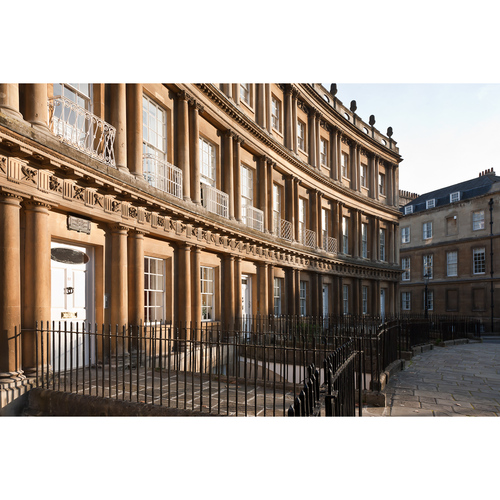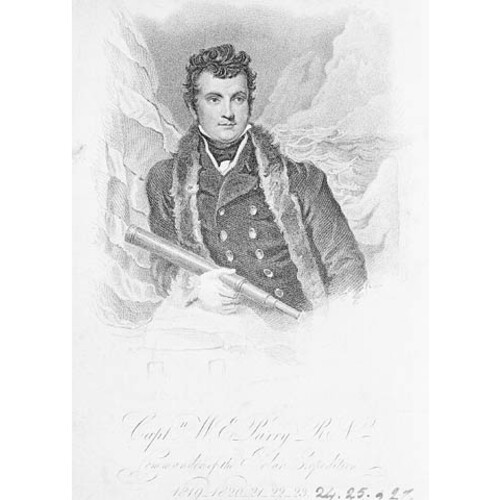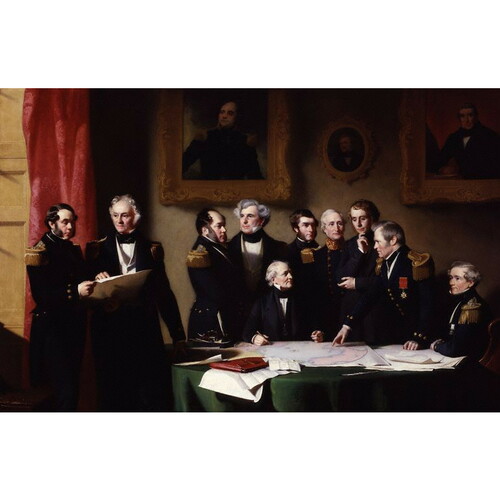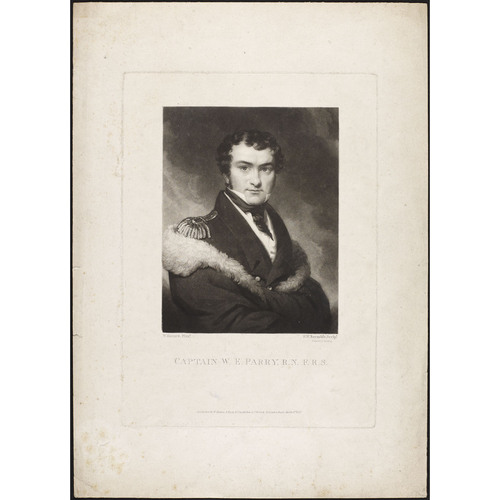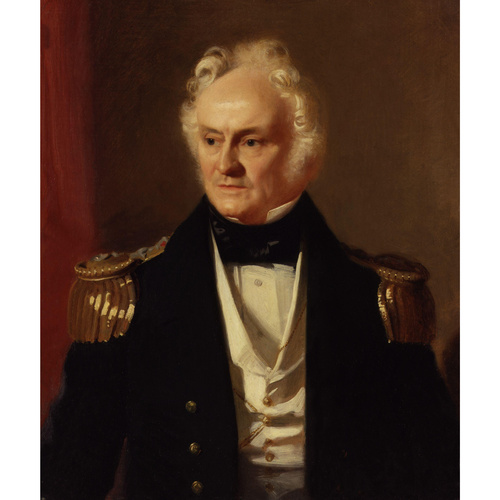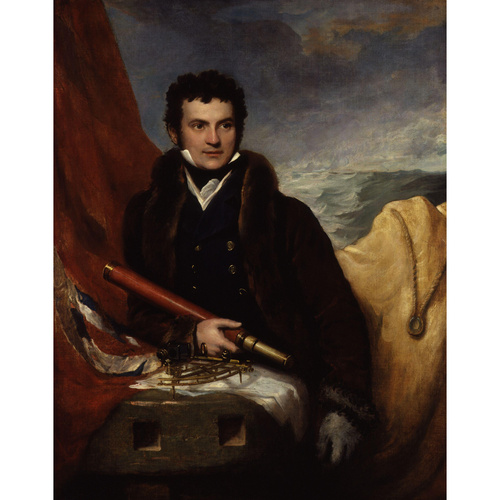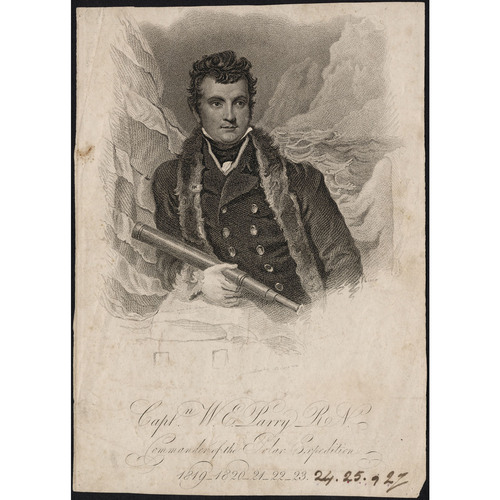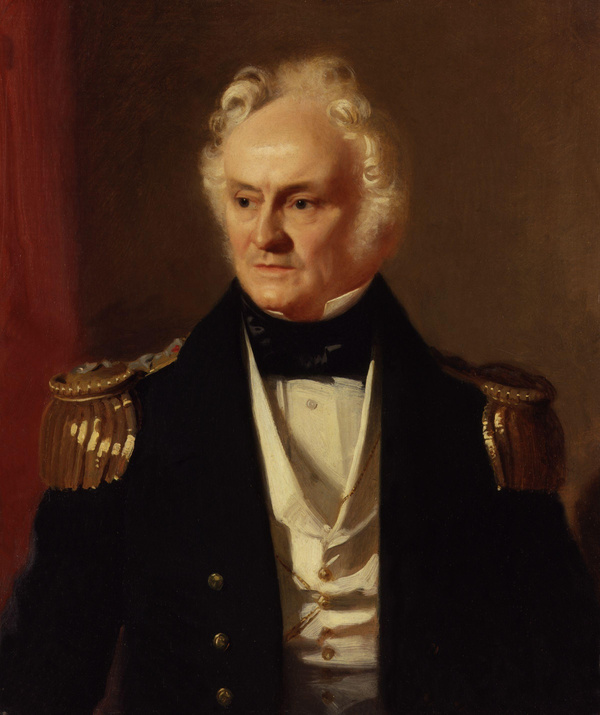
Source: Courtesy of Wikimedia Commons
PARRY, Sir WILLIAM EDWARD, naval officer, Arctic explorer, and hydrographer; b. 19 Dec. 1790 in Bath, England, fourth son of eminent physician Caleb Hillier Parry and Sarah Rigby; m. first 23 Oct. 1826 Isabella Louisa Stanley (d. 13 May 1839), and they had eight children; m. secondly 29 June 1841 Catherine Edwards Hankinson, and they had three children; d. 8 or 9 July 1855 in Ems (Bad Ems, Federal Republic of Germany).
Educated at the Bath Grammar School, William Edward Parry entered the Royal Navy on 30 June 1803. In August of the same year he was rated midshipman and subsequently served aboard various vessels in the English Channel and the Baltic Sea during the Napoleonic Wars. He was promoted lieutenant on 6 Jan. 1810 and was assigned to the Alexandria, on duty protecting the Spitsbergen whale fishery and preparing marine charts in the Shetland Islands and along the coasts of Sweden and Denmark. With the outbreak of hostilities between Great Britain and the United States, Parry was transferred to the North American station and, aboard the Hogue, participated in the destruction of 27 American vessels in the Connecticut River on 6 April 1814. That same year he prepared a short guide on nautical astronomy which was distributed to the officers stationed at Halifax and which was subsequently published. Returning to England early in 1817, Parry applied for and was granted an assignment with one of the Admiralty’s two polar expeditions in search of a northwest passage, one under Commander John Ross and the other under Captain David Buchan*.
On the urging of John Barrow, second secretary of the Admiralty, Parry was given the command of the brig Alexander, which would accompany Ross aboard the sloop Isabella; Ross had instructions to seek a passage from the Atlantic to the Pacific through Davis Strait and Baffin Bay. Weighing anchor at London on 18 April 1818, the two vessels made a short stop in the Shetland Islands before heading west on 3 May. By the end of the month they had reached Davis Strait and, encountering ice floes, then followed the west coast of Greenland north. They continued as far as Smith Sound, where on 19 August Ross named the capes on either side of the sound after his two ships – Cape Isabella on Ellesmere Island and Cape Alexander on Greenland. Having erroneously concluded that the north end of Smith Sound was enclosed by land, Ross headed southwest towards Jones Sound and again mistakenly thought he observed land at the bottom of the inlet. Farther south the entrance to Lancaster Sound was found to be free of ice and on 31 August the two vessels proceeded west into it. As had often been the case during the voyage, the Alexander lagged a considerable distance behind the Isabella. With what appeared to be open water to the west, Parry remarked in his private journal that “the swell comes from the north-west, compass, (that is, south-southwest true,) and continues just as it does in the ocean. It is impossible to remark this circumstance without feeling a hope that it may be caused by this inlet being a passage into a sea to the westward of it.” However, Ross was once again convinced that there was “land round the bottom of the bay,” in the form of a chain of mountains blocking access to the west; he named them after the first secretary of the Admiralty, John Wilson Croker, and turned back to explore the east coast of Baffin Island. Parry, not having seen these mountains, was disappointed by his commander’s decision and remained convinced of the possibility of a passage through Lancaster Sound. The expedition returned to England to avoid wintering in the Arctic, arriving at Deptford (London) on 21 November. Immediately the disagreement between Ross and Parry over the existence of Croker’s Mountains became public, and Barrow was quick to criticize Ross’s decision to turn back.
In order to resolve this confusion the Admiralty commissioned Parry on 16 Jan. 1819 to command a second expedition with specific instructions to investigate Lancaster Sound. Two vessels, the bomb Hecla and the gun-brig Griper, were specially fitted to meet Arctic conditions and sailed on 4 May. By 28 June they had reached Davis Strait. Parry then proceeded across Baffin Bay to Lancaster Sound and, heading into the inlet, discovered that his hopes of the previous year had been well founded and that Croker’s Mountains did not exist. Having for the first time fully equipped an expedition to winter in the Arctic, the Admiralty had instructed Parry to continue westward as far as possible in the hope of reaching Bering Strait. Prince Regent Inlet was briefly explored and found to be closed off by ice, so the two ships pushed through Barrow Strait and along the south shore of the group of islands Parry named the North Georgian Islands (now Parry Islands). For the first time European vessels had penetrated the Arctic Archipelago and, on 4 September, Parry crossed 110°W, off the south shore of Melville Island, earning for the expedition the prize of £5,000 offered by parliament for reaching this longitude.
Progress to the west was soon arrested by the ice, and the Hecla and Griper put into Winter Harbour on Melville Island, where they remained frozen in the ice until 1 Aug. 1820. Before leaving these moorings, Parry led a party of 12 men north across the island and explored the south shore of Hecla and Griper Bay. Unfortunately, westward progress during the second season was halted in the vicinity of Cape Dundas and, after new land (Banks Island) had been sighted to the south, the quest for the passage to the Pacific had to be forsaken and the ships turned back towards Britain. One of the most important naval expeditions to the Arctic, this voyage had not only determined that Lancaster Sound opened a passage towards the west but also laid the groundwork for the mapping of the maze of islands through which the much sought-after northwest passage would have to be traced. Parry had demonstrated the possibility of wintering in relative safety above the Arctic Circle and pioneered techniques for protection against the climate and illness. Landing at Peterhead, Scotland, on 30 October, he proceeded directly to London where he was welcomed by Lord Melville, first lord of the Admiralty, and given his promotion to commander. In England he was publicly honoured by a number of communities and institutions, and in February 1821 he was unanimously elected a fellow of the Royal Society.
Encouraged by the results of the 1819–20 voyage, the Admiralty commissioned Parry to the command of another expedition in search of a northwest passage. The Hecla and the bomb Fury, specially selected and fitted to duplicate the proven sailing characteristics of Hecla, left Deptford on 29 April 1821. Instead of pursuing the path already attempted through Lancaster Sound, Parry had been instructed to penetrate towards the west through Hudson Strait, between Baffin Island and the Ungava Peninsula. He reached the entrance to the strait by the end of June and continued westward to the north of Southampton Island into Repulse Bay, which was discovered to be closed to any further progress to the west. Parry then followed the coast of Melville Peninsula northward, being careful to investigate any possible passage to the west through its various bays and inlets. The expedition explored and charted the southern extremity of the peninsula and then proceeded to Lyon Inlet (which was named for the second officer of the expedition, Commander George Francis Lyon) before the season’s navigation came to a halt. The vessels put into winter quarters off the south shore of Winter Island on 8 October and were quickly frozen into the positions they would keep for the next nine months.
The ships had their masts struck and their sails stowed. The heating system had been improved following the experience of the previous voyage so as to prevent the accumulation of moisture in the cabins and, to the same end, the traditional seamen’s bunks had been replaced by hammocks to permit a freer circulation of air. The Royal Arctic Theatre, fully equipped with costumes and stage lights, was formed by crew members from both ships and presented a program each fortnight. To occupy the men further, a school was established aboard each vessel to teach reading and writing, and an observatory was installed on shore to take magnetic measurements and other scientific observations. The monotony of the long winter was further broken, on I February, by the arrival of a group of Inuit who had settled for the winter about two miles distant and kept in close communication with the expedition. From the Inuit, Parry learned that there was a strait north of Winter Island which provided access to open water to the west, and his hopes of finding the northwest passage were heightened.
The second season of navigation began on 2 July 1822 when Hecla and Fury were freed from the ice. With the help of the information provided by the Inuit, Parry made his way to the entrance of Fury and Hecla Strait, which he so named. Finding it barred by ice and being thus reduced to exploring it on foot, he none the less succeeded in sighting the body of water to the west. At the beginning of October winter quarters were prepared off Igloolik Island, Hooper Inlet, not far from the entrance to the strait, and the expedition passed a second winter in the company of Inuit who also used the island as a winter settlement. It had now become clear, however, that the expedition would not be able to reach its objective, Bering Strait, with the remaining provisions. When finally released from their winter moorings on 9 Aug. 1823, the vessels made one last attempt to explore Fury and Hecla Strait but found the ice still a solid barrier. Parry decided to turn back to England and the expedition arrived in the Thames at the end of October.
Having failed to discover a passage to the Pacific, Parry had none the less charted and explored a considerable area of the Arctic, previously unknown, stretching from Southampton Island north to Baffin Island. In addition, the almost continual contact with the Inuit of Melville Peninsula yielded a wealth of information on their culture, way of life, and language which was included in the published version of Parry’s journal of this voyage.
On 8 Nov. 1821, during his absence, Parry had been promoted captain. On 1 Dec. 1823 he accepted the position of acting hydrographer of the Admiralty on the understanding that he would still be free to command another Arctic expedition. This commission was not long in coming. On 17 Jan. 1824 he was once again given the command of Hecla and Fury with instructions to search for a passage through Lancaster Sound, down Prince Regent Inlet, and then, if possible, along the north coast of North America. Leaving Deptford on 8 May, this expedition was to prove to be Parry’s least successful. Heavy concentrations of ice were encountered in Baffin Bay which delayed its entering Lancaster Sound until 10 September, close to the end of practicable navigation. With considerable difficulty the expedition managed to reach Port Bowen, on the east coast of Prince Regent Inlet, where winter quarters were set up on 1 October. When the ice broke up the following July, Parry headed across to the other side of the inlet in the hope of finding an opening to the west. Fighting against the ice, the Fury was forced aground and severely damaged. There was no sufficiently secure harbour in which to effect the necessary repairs and Parry reluctantly decided to abandon the ship, to take both crews aboard the Hecla, and, because of the strain upon the resources of the one remaining vessel, to return immediately to England. Despite its limited contribution to the exploration of the Arctic this expedition collected significant information on the position of the magnetic pole, arctic wildlife, and other scientific questions.
On his return to England, Parry was formally appointed hydrographer. In spite of his duties he made one last voyage into Arctic waters. Following a plan originally proposed by Captain John Franklin*, he set out aboard Hecla on 4 April 1827 in an attempt to reach the North Pole by crossing the ice north of Spitsbergen. In two boats, Enterprise and Endeavour, fitted to act as sledges on the ice floes, Parry and Lieutenant James Clark Ross*, each commanding a crew of 12 men and one junior officer, took leave of the Hecla at Walden Island, to the north of Spitsbergen, on 21 June. Instead of the relatively unbroken plain of ice he had expected, Parry found himself navigating through a pack of constantly moving small floes and against a southward current which moved the ice four miles south daily, drastically limiting the advance of the party. On 26 July they calculated that they had managed to advance their position only one mile northward in the previous five days, and Parry was forced to turn back to the ship. Not having reached his goal, Parry none the less set a new mark for the farthest north attained, 82°45´, which was not surpassed until 1876 when a sledge party from the expedition under George Strong Nares managed to reach 83°20´26˝. With the men back on the Hecla on 21 August, the expedition set sail for Great Britain, arriving in the Orkney Islands at the end of September 1827.
Parry resumed his duties at the Hydrographic Department until 13 May 1829, when for reasons of health, finances, and career opportunities he resigned. Accepting the offer of the Australian Agricultural Company to administer their operations in New South Wales, Parry agreed to a four-year appointment and was granted leave of absence from the navy. Before leaving England he shared in two public honours with John Franklin: on 29 April both were knighted and, in a joint ceremony at the University of Oxford on 1 July, they each received an honorary dcl degree. Parry served as commissioner of the Australian Agricultural Company, managing the company’s monopoly over a large tract of land, for the four-year term. Upon his return to England in November 1834 no suitable employment with the Admiralty was to be found for him and on 31 Jan. 1835 he applied for the position of assistant poor-law commissioner for the county of Norfolk, a position he held until failing health forced him to resign in February 1836.
At the end of 1836 Parry was appointed by the Admiralty to reorganize the Home Packet Service, which had been transferred from the Post Office Department to the Admiralty, and in three months he succeeded in putting the delivery of mail on a sound footing. When the Steam Department of the Admiralty was created in April 1837, Parry was placed in charge as controller of steam machinery. During his service in this department he was instrumental in the rapid conversion of the Royal Navy to steam and oversaw the introduction of the screw propeller over other forms of steam propulsion. His health, however, was not robust and in November 1846 he requested permission to take his retirement. Instead of accepting his retirement, the Admiralty offered him the post of captain superintendent of the Royal Clarence Victualling Yard and Haslar Hospital, at Gosport near Portsmouth, where he began his duties on 2 December.
At Haslar, one of the largest naval hospitals of its day, Parry had as senior physician and inspector another naval officer renowned for his activity in the Arctic, Sir John Richardson*. Among the reforms effected during Parry’s superintendency were the organization of care for the insane in place of the previous custodial incarceration, an improvement in the standard of nursing, and numerous changes in medical practice.
On 4 June 1852 Parry was promoted rear-admiral and retired to Northbrook House, Bishop’s Waltham, Hampshire. In January 1854, however, he was appointed lieutenant governor of the Greenwich Hospital. His already deteriorating health worsened later that year when he suffered an attack of Asiatic cholera. Never fully recovering, he left in May 1855 for treatment at the baths at Ems, near Koblenz (Federal Republic of Germany), where he died on 8 or 9 July. He was interred in the mausoleum of the Greenwich Hospital on 19 July.
An active member of the Church of England, Parry had been a vigorous opponent of the Tractarian movement and had supported missionary work through such organizations as the Society for Promoting Christianity among the Jews, the Church Missionary Society, the Naval and Military Bible Society, and the British and Foreign Bible Society. In all of his posts, both at sea and ashore, he had gained recognition for his lectures on theology.
As an explorer and navigator in the Arctic, Sir William Edward Parry ranks in importance with Captain James Cook* and Sir James Clark Ross. He was the first explorer to penetrate the Arctic Archipelago and open the passage through Lancaster Sound, Barrow Strait, and Viscount Melville Sound that subsequent expeditions would follow. Furthermore, he was the first to winter in the high Arctic deliberately and, through his experience, he developed techniques necessary for survival in these difficult conditions. Although his participation in Arctic exploration ended in 1827, he maintained a lively interest in the Admiralty’s projects in this region and late in 1848 he was called upon to advise the Admiralty, as a member of the Arctic Council, on the measures to be taken in search of Sir John Franklin’s expedition, lost in the Arctic since 1845. Parry’s contribution to the exploration of the Arctic is recognized in the number of geographical features that bear his name.
Sir William Edward Parry wrote numerous works on exploration in the Arctic. His Journal of a voyage for the discovery of a north-west passage from the Atlantic to the Pacific; performed in the years 1819–20 . . . (London, 1821; 2nd ed., 2v., 1821–24; new. ed., 1v., New York, 1968) was also published in Philadelphia in 1821 (with, as supplement, the North Georgia Gazette, and Winter Chronicle) and in French as Voyage fait en 1819 et 1820, sur les vaisseaux de S.M.B., l’“Hecla” et le “Griper,” pour découvrir un passage du nord-ouest de l’océan Atlantique à la mer Pacifique . . . , [A.-J.-B. Defauconpret, trad.] (Paris, 1822). Following the 1821–23 expedition, he wrote Journal of a second voyage for the discovery of a north-west passage from the Atlantic to the Pacific; performed in the years 1821–22–23 . . . (London, 1824; repr., New York, 1968; another ed., New York, 1824); a supplement containing scientific observations appeared in London in 1825. He then published Journal of a third voyage for the discovery of a north-west passage from the Atlantic to the Pacific; performed in the years 1824–25 . . . (London, 1826; another ed., Philadelphia, 1826) and Narrative of an attempt to reach the North Pole, in boats fitted for the purpose, and attached to his majesty’s ship “Hecla,” in the year MDCCCXXVII . . . (London, 1828). These accounts were republished in three collections: Journals of the first, second and third voyages for the discovery of a north-west passage from the Atlantic to the Pacific, in 1819–20–21–22–23–24–25 . . . (5v., London, 1828); Voyages for the discovery of a north-west passage, 1819–25; and narrative of an attempt to reach the North Pole, 1827 (8v., London, 1821–28); Three voyages for the discovery of a north-west passage from the Atlantic to the Pacific, and narrative of an attempt to reach the North Pole (2v., New York, 1842). He also wrote Nautical astronomy by night; comprehending practical directions for knowing . . . the principal stars . . . in the northern hemisphere . . . (Bath, Eng., 1816); Thoughts on the parental character of God (London, 1841; 5th ed., 1855; new. ed., 1878), published in German as Der vatersinn Gottes . . . (Berne, Switzerland, 1844); A lecture on the character, condition, and responsibilities of British seamen (London, 1855).
Evangeliche Pfarramt II (Westbezirk) Bad Ems (Federal Republic of Germany), Evangeliche Kirchengemeinde Bad Ems, Sterberegister, 8 July 1855. Gentleman’s Magazine, July–December 1855: 200–2. John Ross, A voyage of discovery, made under the orders of the Admiralty, in his majesty’s ships “Isabella” and “Alexander, “for the purpose of exploring Baffin’s Bay, and enquiring into the probability of a north-west passage (2nd ed., 2v., London, 1819). Boase, Modern English biog., 2: 367–68. Cooke and Holland, Exploration of northern Canada. L. S. Dawson, Memoirs of hydrography including brief biographies of the principal officers who have served in H.M. Naval Surveying Service between the years 1750 and 1885 (2v., Eastbourne, Eng., 1885; repr. in 1v., London, 1969), 1: 97–103. O’Byrne, Naval biog. dict. (1849), 865–66. John Barrow, Voyages of discovery and research within the Arctic regions, from the year 1818 to the present time . . . (London, 1846). R. E. Johnson, Sir John Richardson: Arctic explorer, natural historian, naval surgeon (London, 1976). Ann Parry, Parry of the Arctic; the life story of Admiral Sir Edward Parry, 1790–1855 (London, 1963). Edward Parry, Memoirs of Rear-Admiral Sir W. Edward Parry, Kt., F.R.S., etc. late lieut.-governor of Greenwich Hospital (2nd ed., London, 1857). F. W. Beechey, “Address to the Royal Geographical Society of London; delivered at the anniversary meeting on the 26th May, 1856,” Royal Geographical Soc., Journal (London), 26 (1856): clxxxii–clxxxv.
Cite This Article
Robert E. Johnson, “PARRY, Sir WILLIAM EDWARD,” in Dictionary of Canadian Biography, vol. 8, University of Toronto/Université Laval, 2003–, accessed April 1, 2025, https://www.biographi.ca/en/bio/parry_william_edward_8E.html.
The citation above shows the format for footnotes and endnotes according to the Chicago manual of style (16th edition). Information to be used in other citation formats:
| Permalink: | https://www.biographi.ca/en/bio/parry_william_edward_8E.html |
| Author of Article: | Robert E. Johnson |
| Title of Article: | PARRY, Sir WILLIAM EDWARD |
| Publication Name: | Dictionary of Canadian Biography, vol. 8 |
| Publisher: | University of Toronto/Université Laval |
| Year of revision: | 1985 |
| Access Date: | April 1, 2025 |


